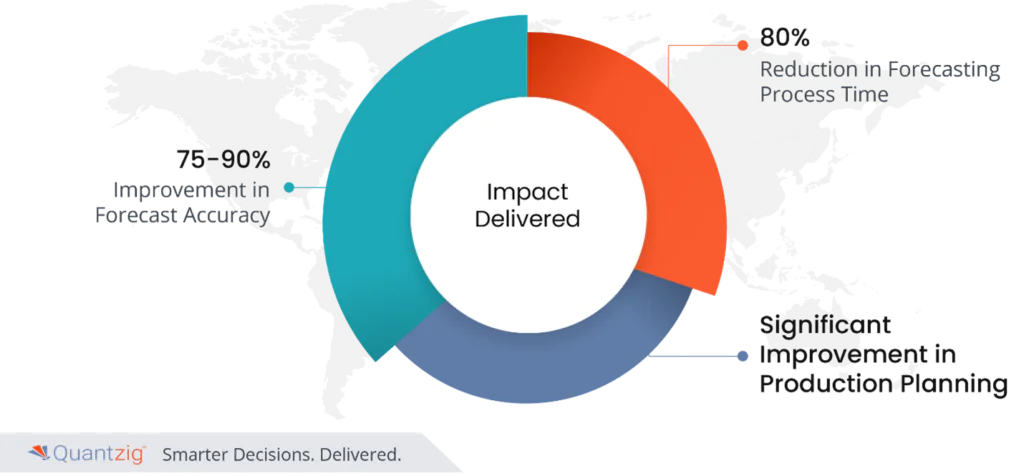In the realm of industrial manufacturing, precision is paramount, and the accuracy of forecasting processes can be the linchpin between success and inefficiency. In our recent collaboration with an industrial manufacturing giant, we undertook the challenge of mitigating production costs stemming from inaccuracies in their forecasting methods. Armed with innovative solutions, we endeavored to revolutionize their approach, harnessing advanced technologies to enhance forecast accuracy. This partnership became a strategic intervention, addressing not just immediate cost concerns but fundamentally reshaping how our client approached production planning. The narrative that unfolds is one of how our tailored solutions paved the way for this industrial giant to not only streamline their processes but to fortify their position as a leader in an intensely competitive landscape, where precise forecasting is the key to operational excellence and sustained profitability.

Table of Contents
Summary
Client: The client was a leading industrial manufacturer with over $4Bn in revenue, operating more than 20 manufacturing and 70 warehouses worldwide.
Challenge: The Company was experiencing significant losses due to inaccurate forecasting sales, with stockouts and IHC combinedly causing losses of around 20%. The existing demand forecasting solution was working on a one-fit-all approach and completely missed the signals coming from the marketing side. Because of forecast inaccuracy, the client was experiencing a pile-up for SKUs and stockouts for some SKUs which were combinedly costing over $200Mn.
Solution: The loss forecasting model was built using advanced modeling techniques, including machine learning and statistical algorithms, and leveraged various knowledge forums and platforms to identify the key influencing factors for deal conversion. Quantzig developed an objective KED framework and win/loss predictor that enabled the client to track critical variables and performance metrics related to salesforce performance.
Impact Delivered
All of the above initiatives resulted in:
- 75-90% improvement in forecast accuracy
- 80% reduction in forecasting process time
- Significant improvement in production planning
Industry Overview
- The manufacturing industry is a critical component of the US economy, accounting for approximately $2.3 trillion of the country’s total GDP.
- The US manufacturing industry employs approximately 12 million people, representing a large number of the country’s workforce.
- In recent years, the industry has faced significant challenges, including global competition, supply chain disruptions, and talent shortages. Despite these challenges, the US manufacturing industry has continued to innovate and evolve, leveraging advanced technologies such as automation, AI, and data analytics to improve productivity, quality, and efficiency
About the Client
- Our recent client was a leading industrial manufacturer based in the USA, with staggering annual revenue of more than $4 billion.
- The client had a complex manufacturing process and was operating more than 20 manufacturing and 70 warehouses worldwide, making it truly a global enterprise.
Challenges
- The client’s existing demand forecasting solution, while intended to provide insights into customer demand patterns, was limited by a one-fit-all approach that failed to capture the nuances and complexities of the client’s marketing efforts. As a result, the solution was ill-equipped to detect and respond to the various signals emanating from the marketing side of the business, including changes in customer preferences, competitor activity, and emerging market trends. This lack of sensitivity to marketing signals meant that the existing demand forecasting sales solution was unable to provide the level of granularity and accuracy required to support effective decision-making, ultimately resulting in missed opportunities and suboptimal outcomes for the client.
- They had been grappling with significant challenges resulting from forecast inaccuracy, with a notable consequence being the accumulation of excess inventory for some SKUs, while others experienced frequent stockouts, resulting in combined costs exceeding $200 million.These challenges were indicative of a broader issue, as the existing forecasting models were failing to capture the intricacies of the market, including customer demand patterns, supply chain disruptions, and emerging trends, leaving them ill-equipped to make informed decisions about inventory management, production planning, and demand forecasting. As a result, the client was experiencing significant financial losses, missed opportunities, and a less-than-optimal competitive position, underscoring the critical need for a more robust and accurate loss forecasting model.
- The client recognized the pressing need for a more accurate demand forecasting solution that could address the significant challenges they were facing, including stock-outs, excess inventory, and the associated financial losses. Specifically, they sought a loss forecasting model that could predict demand with at least a 20% improvement in overall accuracy, enabling the client to make more informed decisions about inventory management, production planning, and other critical supply chain operations.
Solutions
- Drawing on its expertise in data analytics and machine learning, Quantzig undertook an extensive research effort, aggregating data from various knowledge forums and platforms, to identify the key influencing factors for deal conversion. The research effort focused on analyzing a range of critical variables, including deal size, incumbent vendor, business segment, opportunity type, product, time, seasonality, and other relevant factors, to uncover the underlying patterns and trends driving customer behavior and purchase decisions. Through the aggregation and analysis of this forecasting sales data, they were able to gain a more comprehensive understanding of the complex and nuanced market dynamics that were affecting the client’s business.
- To ensure that the client could leverage the insights generated by the loss forecasting model, Quantzig developed an objective KED Framework that enabled the client to track the critical variables and performance metrics. Leveraging the KED Framework, our team built a mechanism that enabled the company to monitor salesforce performance against the KEDs, providing them with real-time insights into how their salesforce was performing and where potential opportunities for improvement existed. This mechanism allowed the client to identify and address the performance gaps and bottlenecks, optimize their sales processes, and ultimately drive better business outcomes. By leveraging the loss forecasting model in conjunction with the KED framework, and performance tracking mechanism, the client was able to reduce the incidence of stock-outs and excess inventory.
- Further, Quantzig developed a cutting-edge win/loss predictor that enabled the client to accurately forecast sales outcomes and optimize their sales processes based on critical variables such as deal size, product, customer segment, and other key factors. Through the application of advanced modeling techniques, the win/loss predictor underlined the drivers of sales success and failure and mitigated the financial losses associated with inaccurate demand forecasting.
In conclusion, our collaboration with the industrial manufacturing giant stands as a testament to the transformative impact of precision in forecasting on production costs. By addressing the inherent inaccuracies in their forecasting processes, we have not merely cut costs; we have redefined the very foundation of their operational efficiency. This strategic intervention positions the manufacturing giant as an agile and cost-effective industry leader. The reduction in production costs is not just a financial achievement but a competitive advantage in an environment where efficiency and accuracy are paramount. Our tailored solutions have not only optimized their current cost structures but have equipped them with the resilience needed to navigate the complexities of industrial manufacturing. This success story exemplifies how refining forecasting processes can pave the way for sustained profitability and market dominance in the fiercely competitive landscape of industrial manufacturing.


